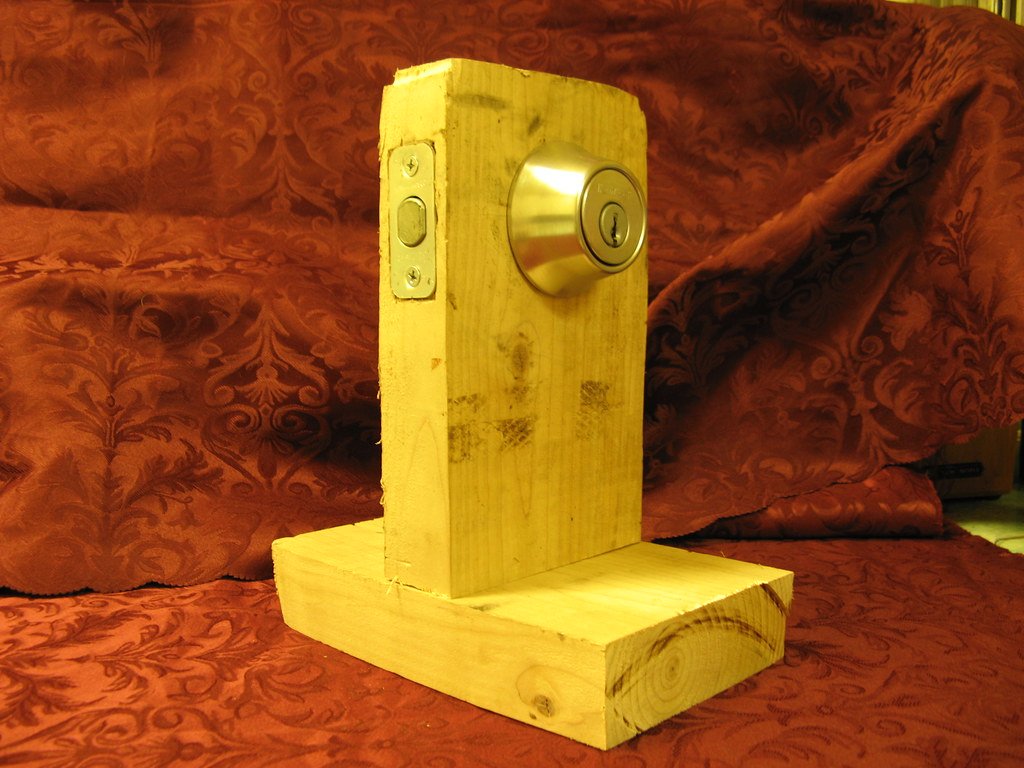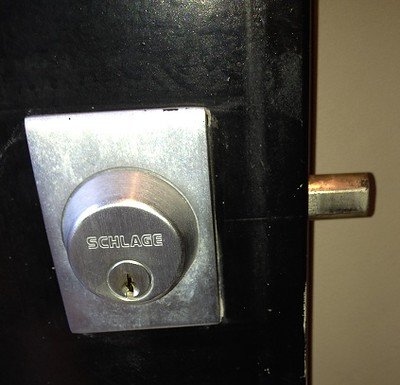Imagine this: you step inside your home, sensing an air of tranquility as the door swings shut behind you. With a reassuring click, the world outside melts away, leaving you in a domain untouchable by the chaos beyond. At that moment, you find solace in the knowledge that your trusty deadbolt stands as the guardian of your sanctuary. But have you ever stopped to wonder what makes deadbolts so secure? Behind their unassuming exterior lies a remarkable science, carefully engineered to thwart the most determined intruders. In this article, we delve into the intricate workings of deadbolts, unveiling the secrets that make them the stalwart protectors of our homes. Prepare to witness a symphony of strength, precision, and ingenuity, as we unravel the captivating science behind deadbolts: a symphony that ensures your peace of mind.
Table of Contents
- The Anatomy of Deadbolts: Understanding Their Construction
- Exploring the Physics of Deadbolts: How They Provide Added Security
- Materials Matter: Choosing the Right Deadbolt for Maximum Safety
- Unlocking the Secrets: How Deadbolts Keep Intruders at Bay
- Installation Techniques: Ensuring Proper Placement and Functionality
- Q&A
- In Summary

The Anatomy of Deadbolts: Understanding Their Construction
When it comes to securing our homes, deadbolts are a crucial component that provides an extra layer of protection. To truly understand their effectiveness, it’s essential to delve into the anatomy of deadbolts and explore their construction. By doing so, we can gain valuable insights into why they are considered one of the most reliable types of locks available.
Deadbolts consist of several key components that work together to provide superior security. The main parts of a deadbolt lock include:
- Deadbolt Cylinder: This is the part of the lock where the key is inserted. It consists of a cylindrical tumbler mechanism, pins, and springs, allowing for precise key control.
- Strike Plate: When the deadbolt is engaged, the bolt extends into the strike plate, which is attached to the door frame. The strike plate reinforces the door frame, providing resistance against forced entry.
- Bolt: The bolt is the metal rod that extends or retracts when the deadbolt lock is operated. It is typically made of hardened steel, ensuring durability and strength.
- Latch Plate: The latch plate, also known as the throw, is the component that the bolt connects with when it is fully extended. It helps hold the door securely closed.
Understanding the construction of deadbolts empowers homeowners to make informed decisions when choosing the right lock for their needs. Whether it’s the quality of materials used or the complexity of the locking mechanism, every detail contributes to the overall security provided by deadbolts.

Exploring the Physics of Deadbolts: How They Provide Added Security
When it comes to securing our homes, deadbolts are a go-to option for many homeowners. But have you ever wondered how deadbolts actually work? Let’s dive into the fascinating world of physics and understand the science behind deadbolts’ ability to provide added security.
At first glance, deadbolts may seem like a simple mechanism, but their effectiveness lies in the unique physics involved. One crucial factor is the force distribution. Unlike spring-loaded latch locks, deadbolts rely on a solid metal bolt that firmly extends into the door frame. This design ensures that the force applied to the lock is evenly distributed across a larger surface area, making it much more challenging to break through.
- Bolt diameter and length: Deadbolts come in various sizes, and the diameter and length of the bolt also contribute to their strength. A thicker and longer bolt provides greater resistance against external force.
- Materials and construction: The materials used in deadbolt construction play a significant role in their security level. Premium deadbolts feature hardened steel bolts that are highly resistant to drilling, cutting, or sawing.
- Locking mechanisms: Deadbolts incorporate different locking mechanisms to enhance security. One common type is the double-cylinder deadlock, which requires a key to lock and unlock the door from both inside and outside. This prevents burglars from gaining access by breaking a nearby window and reaching in to unlock the door.
Understanding the physics behind deadbolts highlights why they are considered an essential element of home security. By using solid construction, strategic force distribution, and advanced locking mechanisms, deadbolts provide a robust defense against unwanted intruders. Next time you turn that key or slide that bolt, remember the science that keeps your home safe.

Materials Matter: Choosing the Right Deadbolt for Maximum Safety
Choosing the Right Deadbolt: Prioritizing Safety First
When it comes to securing your home or office, the selection of a deadbolt is a crucial decision. The right deadbolt can significantly enhance your security, instilling a sense of peace and comfort. With an array of options available in the market, it is important to understand that materials matter when it comes to deadbolts.
1. Solid Brass: If durability is your priority, solid brass deadbolts are an excellent choice. Apart from being sturdy and resistant to corrosion, their elegance adds a touch of sophistication to any entryway.
2. Stainless Steel: Known for its strength and durability, stainless steel deadbolts offer reliable security. Their resistant nature against tampering and weather conditions makes them suitable for both residential and commercial use.
3. Nickel: Aesthetically pleasing and durable, nickel deadbolts can effortlessly match any decor. They provide satisfactory protection while adding a modern touch to your doors.
4. Powder-Coated Steel: For those seeking a more affordable option without compromising on security, powder-coated steel deadbolts are a great alternative. Their durable construction and resistance to rust make them a reliable choice.
Remember, choosing the right deadbolt is crucial for maximum safety. Thoroughly consider your specific needs and preferences, and never underestimate the importance of materials when it comes to securing your property.

Unlocking the Secrets: How Deadbolts Keep Intruders at Bay
Imagine this scenario: it’s 2 am, and you find yourself tossing and turning in bed, unable to sleep. Suddenly, a noise downstairs startles you. Your heart races, and you slowly realize there’s a potential intruder in your home. In moments like these, deadbolts become your silent guardian, keeping the unwanted out and providing you with a sense of security.
Deadbolts are not ordinary locks; they are the superheroes of the security world. With their sturdy construction and unique design, they offer unparalleled protection for your doors. These locks consist of a thick metal bolt that extends into the doorframe, making it nearly impossible for intruders to force their way in without considerable effort. It’s like Fort Knox for your home, deterring even the most determined burglars.
Let’s dive deeper into the secrets of how deadbolts work their magic. Here are a few key features that make them such formidable protectors:
- 1. Solid Durability: Deadbolts are made of robust materials, such as solid steel or brass, ensuring their durability against tampering or brute force attacks. It’s like having a security barrier that can withstand the test of time.
- 2. Enhanced Security: Unlike regular locks that rely on spring mechanisms, deadbolts offer a higher level of security. Their bolts are engaged or disengaged by rotating a key or thumbturn, making it nearly impossible to pick or bump them open.
- 3. Single Purpose Strength: Deadbolts are designed purely for security and are not easily compromised. They lack the latch mechanism found in regular locks, eliminating vulnerabilities and making them impervious to unauthorized entry.
In conclusion, deadbolts are the unsung heroes that go above and beyond in protecting your home. With their unwavering strength and resilience, they provide peace of mind and keep intruders at bay. So next time you turn the key in your deadbolt, remember that you’re unlocking more than just a door; you’re unlocking a world of safety and security.
Installation Techniques: Ensuring Proper Placement and Functionality
When it comes to installing any device or equipment, proper placement and functionality are key to achieving optimal performance. To ensure a seamless installation process, follow these expert techniques:
1. Assess the Environment:
Before diving into the installation process, carefully evaluate the environment where the equipment or device will be placed. Consider factors such as temperature, humidity, and potential interference from other devices. This assessment will help determine the most suitable location to ensure optimal functionality.
2. Follow Manufacturer Guidelines:
Manufacturers provide detailed instructions for installation, and it’s important to follow them diligently. These guidelines often include specific placement requirements, recommended wiring techniques, and essential safety precautions. By adhering to these instructions, you can ensure that the equipment functions correctly and avoid any unnecessary complications.
3. Test and Troubleshoot:
Once the installation is complete, testing the functionality of the equipment is crucial. Go through a series of tests to ensure that all components are working properly. Troubleshoot any issues that arise promptly to identify and resolve any potential problems. This step will help guarantee that the device or equipment operates smoothly.
By implementing these installation techniques, you can achieve proper placement and functionality, ensuring the best performance from your devices or equipment.
Q&A
How do deadbolts provide security?
Deadbolts are secure because they extend deep into the door frame, making it difficult for intruders to force the door open. The solid metal construction and unique locking mechanism provide an added layer of protection.
What makes deadbolts stronger than regular locks?
Unlike regular locks that rely on springs and simple mechanisms, deadbolts use a solid metal bolt that extends into the strike plate, providing a higher level of resistance against forced entry.
Why are deadbolts considered more secure than other types of locks?
Compared to other locks, deadbolts offer greater resistance to picking, bumping, and drilling attempts. Their solid metal construction and lack of exposed springs make them highly reliable and difficult to breach.
How do deadbolts prevent kick-in attacks?
Deadbolts are specifically designed to prevent kick-in attacks. Their long bolts and sturdy strike plates distribute force over a larger area, making it challenging for intruders to break through the door by force alone.
Are all deadbolts equally secure?
No, not all deadbolts are equally secure. High-quality deadbolts that meet industry standards, such as those with Grade 1 ratings, offer the highest level of security. It’s important to choose deadbolts from reputable manufacturers and ensure proper installation for maximum effectiveness.
Can deadbolts be picked by experienced intruders?
While no lock is completely unpickable, high-quality deadbolts with complex cylinder mechanisms and additional security pins greatly reduce the chances of being picked. Skilled intruders would face significant challenges when attempting to pick a robust deadbolt.
What are some additional features that can enhance deadbolt security?
Reinforcing the door frame with strike plates that extend into the wall can greatly enhance deadbolt security. Additionally, using longer screws that penetrate deep into the studs strengthens the overall door structure and adds an extra layer of protection against forced entry.
Can smart deadbolts be as secure as traditional deadbolts?
Smart deadbolts that use advanced encryption and authentication protocols can offer the same level of security as traditional deadbolts. However, it’s vital to choose reputable brands and ensure proper setup and maintenance to maintain optimal security levels.
In Summary
As we conclude our deep dive into the riveting world of deadbolts, we find ourselves basking in the glow of knowledge and marveling at the intricate mechanisms that fortify our homes. The science behind these unyielding sentinels has opened our eyes to the ingenuity and creativity that exists within the realm of security systems.
It is an astonishing fusion of art and engineering that gives birth to the resolute nature of deadbolts. From their sturdy construction to their impenetrable strength, each component interlocks seamlessly, forming an impenetrable barrier against any unwelcome intruder.
Yet, amidst the intricate mechanics lies something far more profound – trust. Trust in these unassuming metallic guardians that stand guard day and night, quietly ensuring the safety of our loved ones and cherished possessions. The peace of mind that comes from knowing we have equipped our homes with the strongest line of defense is unparalleled.
We have unraveled the mystery behind the deadbolt’s extraordinary security, discovering the power of robust materials and precision engineering. We have delved into the world of cylinder locks, their complex pin tumbler systems, and the genius of master keying. With this knowledge in our arsenal, we can now make informed choices, fortifying our homes and safeguarding our loved ones.
The science behind deadbolts shines a light on the ceaseless quest to innovate and evolve. Security experts are continuously pushing boundaries, refining existing solutions, and introducing groundbreaking ideas to outsmart potential threats. It is this unyielding dedication that fuels progress, leaving us with an ever-increasing sense of security.
As we bid farewell to the captivating world that lies behind the deadbolt, let us carry this newfound wisdom and appreciation into our lives. May we continue to seek safety and security, recognizing the value of these steadfast companions that guard our homes. With a firm grip on knowledge and an unwavering commitment to fortify our surroundings, may we always cherish the sanctity of our private spaces.
As an affiliate, my content may feature links to products I personally use and recommend. By taking action, like subscribing or making a purchase, you’ll be supporting my work and fueling my taco cravings at the same time. Win-win, right?
Want to read more? Check out our Affiliate Disclosure page.